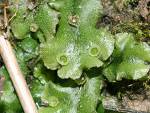

THE BRYOPHYTES
| Like the rest of land plants, the Bryophytes are Embryophytes (plants that produce an embryo) and they have traditionally been viewed as a distinct lineage from other land plants. They are not considered to have given rise to the vascular plants but they probably were the earliest land plants (Qui & Palmer, 1999). Like the rest of the land plants, they evolved from green algal ancestors, closely related to the Charophytes. They are a group of simple land plants, well-adapted to moist habitats.
|
Bryophytes, in contrast,
- have no lignin usually
- are small, low-lying, (generally) moisture-loving plants
- have no roots, only filamentous rhizoids
THE ONLY LAND PLANTS WITH A DOMINANT GAMETOPHYTE!
The sporophyte is parasitic on the gametophyte. This stems from the embryo being retained in the female sex organ of the gametophyte.
There are 3 groups of Bryophytes;-
|
| Mosses (~10,000 species) |
|
| Liverworts |
|
| Hornworts (not covered in this course) |
| These are generally viewed as three monophyletic lineages emerging from the very earliest land plants. | |
Liverworts can also be distinguished from mosses by the possession of oil bodies, unique organelles. Oil droplets in mosses and other land plants are just naked blobs of fat but liverwort oil bodies are single membrane-bound organelles and contain essential oils (terpenoids).
Liverwort leaf cells each containing two to five (grey) oil bodies (as well as numerous chloroplasts).
Photo © Steven L. Jessup, Southern Oregon University
Role of Bryophytes
- Many are pioneer plants, growing on bare rock and contributing to soil development.
- In bogs and mountain forests they form a thick carpet, reducing erosion.
- In forest ecosystems they act like a sponge retaining and slowly releasing water
- They provide habitat for other plants and small animals as well as microorganisms like N2-fixing blue-green bacteria
- Lacking a cuticle and transport tissue they readily absorb whatever is around them and can serve as bioindicators of pollution and environmental degradation
| Bryophyte Physiology These plants all require moist conditions for at least part of their life cycle. If really wet, they may grow as epiphytes (plants that grow on other plants). Many mosses are quite resistant to desiccation. They can lose water in the dry season, become dormant and then imbibe water or spring back to life when it rains. Similarly, many temperate mosses can survive freezing and thawing without damage. Being prostrate, Bryophytes have much of their surface in contact with the substratum and readily absorb moisture this way. Water often is drawn along the surface of these plants by capillarity and this external water movement is important. In certain mosses, specialised transport cells, hydroids and leptoids, analogous to the xylem and phloem of vascular plants, are found at the centre of the stem. | ||
| Gases simply diffuse across the plant surface but liverworts also have special pores which are permanently open for gas exchange. Certain mosses also have stomata on their capsules (sporophytes). | | |
Mosses and leafy liverworts can be confused.
- Leaves of leafy liverworts never have a mid-rib (unlike those of most mosses).
- Mosses have multicellular rhizoids vs. the unicellular rhizoids of liverworts
- The capsules are quite different, as we will see
- Moss leaves are of equal size and spirally arranged while the main leaves of liverworts are arranged in one plane on either side of the stem with a third row of smaller leaves on the underside of the stem.
- Moss leaves are never lobed
- Oil bodies occur in the leaves of 90% of liverworts, but are absent from moss leaves






1 comment:
hai kita (dayu n puput)udah buka briofitanya tapi kok bhs inggrs sh bu......duh... cape dehh...hiks...hiks.... gmn belajarnya donk bu....versi indonesianya ada nggak bu...?????hehehe.......
Post a Comment